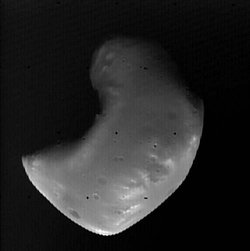Deimos (moon)
|
|
| An image of Deimos taken by the Viking 1 orbiter. | |
| Discovery | |
|---|---|
| Discovered by | Asaph Hall |
| Discovered on | August 12 1877 |
| Orbital characteristics | |
| Mean radius | 23,460 km |
| Eccentricity | 0.0002 |
| Revolution period | 1.262 d |
| Avg. Orbital Speed | 0.22 km/s |
| Inclination | 1.793° |
| Satellite of | Mars |
| Physical characteristics | |
| Mean diameter | 12.6 km (15.0×12×10.4) |
| Mass | 2.244×1015 kg |
| Mean density | 2.2 g/cm3 |
| Surface gravity | 0.0039 m/s² (3.9 mm/s²) |
| Surface Gravity (Earth = 1) | 0.00040 (400 µg) |
| Escape Velocity | 0.0069 km/s (6.9 m/s) |
| Rotation period | synchronous |
| Albedo | 0.07 |
| Surface temp. | ~313 K |
| Atmospheric pressure | no atmosphere |
Deimos (dye'-mus or dee'-mus; Greek Δείμος) is the smaller and outermost of Mars' two moons, named after Deimos from Greek Mythology.
| Contents |
Discovery
Phobos and Deimos were both discovered by American astronomer Asaph Hall. The names were suggested by Henry Madan (1838–1901), Science Master of Eton, from Book XV of the Iliad, where Ares summons Fear (Deimos) and Fright (Phobos).
Deimos was discovered on August 12, 1877 at about 07:48 UTC (given in contemporary sources as "August 11 14:40" Washington mean time using the old astronomical convention of beginning a day at noon, so 12 hours must be added to get the actual local mean time). [1] (http://adsabs.harvard.edu//full/seri/AN.../0091//0000013.000.html) It has been designated Mars II.
Characteristics
Deimos is probably an asteroid that was perturbed by Jupiter into an orbit that allowed it to be captured by Mars, though this hypothesis is still in some dispute. Like most bodies of its size, Deimos is highly nonspherical with dimensions of 15×12×10 km.
Deimos is composed of carbon-rich rock, much like C-type (carbonaceous chondrite) asteroids, and ice. It is cratered, but the surface is noticeably smoother than that of Phobos, caused by the partial filling of craters with regolith. The two largest craters, Swift and Voltaire, measure about 3 kilometers across.
As seen from Deimos, Mars would be 1000 times larger and 400 times brighter than the full Moon as seen from Earth, taking up a full 1/11 of the width of a celestial hemisphere.
13-ml-04-deimos-A067R1.jpg
As seen from Mars, Deimos has an angular diameter of no more than 2.5' and would therefore appear starlike to the naked eye. At its brightest ("full moon") it would be about as bright as Venus is from Earth; at the first or third quarter phase it would be about as bright as Vega. When Deimos passes in front of the Sun its angular diameter is only about 2.5 times the angular diameter for Venus during a transit of Venus from Earth.
Unlike Phobos, which orbits so fast that it actually rises in the west and sets in the east, Deimos rises in the east and sets in the west. However, the orbital period of Deimos of about 30.5 hours exceeds the Martian solar day ("sol") of about 24.5 hours by such a small amount that it takes 2.7 days between rising and setting for an equatorial observer.
Phobos_Deimos_orbit_Mars.jpg
Because Deimos' orbit is relatively close to Mars and has only a very small inclination to Mars' equator, it cannot be seen from Martian latitudes greater than 82.7°.
Deimos in fiction
- Kim Stanley Robinson's Green Mars (1993) includes a detailed description of a manned landing on Deimos.
References
- Robert S. Richardson, "If You Were on Mars", Astronomical Society of the Pacific Leaflets, 4 (1943) 214 (http://adsabs.harvard.edu//full/seri/ASPL./0004//0000214.000.html) (1943ASPL....4..214R) (Leaflet No. 178, December 1943)
Contemporary accounts of the discovery of Phobos and Deimos:
- The Observatory, 1 (1877) 181 (http://adsabs.harvard.edu//full/seri/Obs../0001//0000181.000.html)
- Astronomische Nachrichten, 91 (1878) 11/12 (http://adsabs.harvard.edu//full/seri/AN.../0091//0000013.000.html)
- Monthly Notices of the Royal Astronomical Society, 38 (1878) 205 (http://adsabs.harvard.edu//full/seri/MNRAS/0038//0000205.000.html)
- Astronomische Nachrichten, 92 (1878) 47/48 (http://adsabs.harvard.edu//full/seri/AN.../0092//0000031.000.html)
See also
- Phobos, the other moon of Mars
- List of features on Phobos and Deimos
- Transit of Deimos from Mars
External links
- Deimos rotation movie (http://www.solarviews.com/cap/mars/vdeimos3.htm)
- Animation of Deimos (http://www.solarviews.com/cap/mars/vdeimos1.htm)
| Our Solar System |
| Sun | Mercury | Venus | Earth (Moon) | Mars | Asteroid belts |
| Jupiter | Saturn | Uranus | Neptune | Pluto | Kuiper belt | Oort cloud |
| See also astronomical objects and the solar system's list of objects, sorted by radius or mass |
ca:Satèl·lit Deimos de:Deimos (Mond) es:Deimos (luna) eo:Dejmo fr:Déimos (lune) he:דימוס (ירח) it:Deimos (luna) nl:Deimos (maan) ja:ダイモス (衛星) no:Deimos pl:Deimos pt:Deimos ru:Фобос и Деймос sl:Deimos (luna) fi:Deimos sv:Deimos (måne) zh:火卫二

